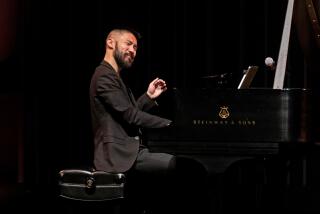Randy Weston Enthralls Crowd; Less Is Less With Yusef Lateef
The presence of Randy Weston and Yusef Lateef at Cal State L.A.âs Luckman Fine Arts Complex on Saturday night offered a rare occasion to hear two veteran jazz explorers on the same stage.
Westonâs solo set was a delight, the product of a musical imagination that roved freely through crusty dissonances and rhapsodic melodizing. More, it was music that had no difficulty embracing intellectual concepts, dancing rhythms and good-humored whimsy.
Weston, who turned 75 earlier this month, is that most admirable of jazz entities: a complete artist, comfortable in every aspect of expression. A solid bop player, one of the most insightful interpreters of the music of Thelonious Monk, a composer and arranger, he broadened his abilities even further via years of living in Morocco.
All of those qualities were present in a pair of extended, purely impromptu medleys. In the first--which Weston described as an example of âthis funny trip of jazzâ--he wandered through a virtual musical stream-of-consciousness. Making occasional stops at his own piece, âHi-Fly,â and Dizzy Gillespieâs âNight in Tunisia,â adding various Monk references, he had the full-house, enthusiastic crowd enthralled--entertaining, enlightening and thrilling, all in one marvelous sweep of music.
He followed with a brief spoken description of the healing qualities that are associated with music in Moroccan culture, illustrating with a traditional theme he called âBlue Mosesâ--yet another example of Westonâs creative capacity to synthesize strikingly different culture elements into his own musical vision. It was a rare and welcome opportunity to hear a master at work.
The Lateef portion of the evening, performed with Adam Rudolph and Eternal Wind (Federico Ramos, Ralph Jones and Charles Moore), began interestingly with a long, atmospheric setting. Lateefâs sensual flute, hovering over drone-like pedal notes and murmuring percussion, reflected the musical and aesthetic multiculturalism he has been exploring, individually and with Rudolph, for decades.
As the set slowly unfolded, however, atmosphere too often took precedence. Despite occasional bursts of activity, with attractive and versatile percussion work from Rudolph, who even added a bit of overtone singing), Lateefâs overall role was far too minimal in a performance that would have benefited from a larger portion of his well-established musical powers.
More to Read
The biggest entertainment stories
Get our big stories about Hollywood, film, television, music, arts, culture and more right in your inbox as soon as they publish.
You may occasionally receive promotional content from the Los Angeles Times.










